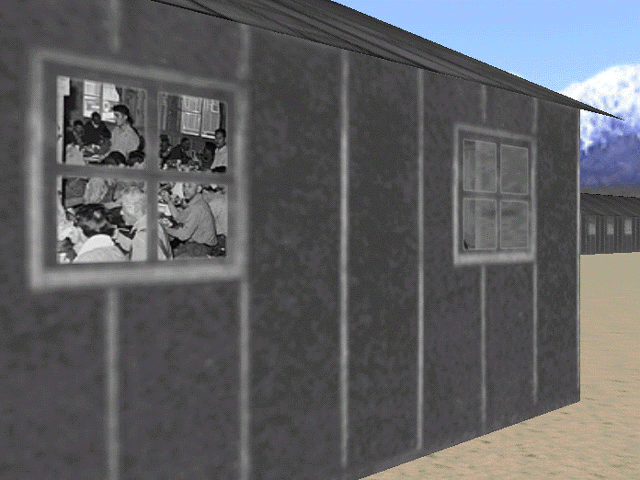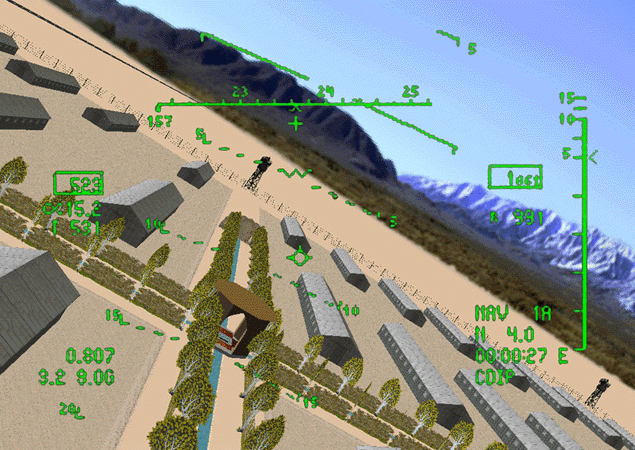What’s the boundary between “virtual” reality and actual reality? Virtual reality’s original meaning, according to Christiane Paul in Digital Art, is “a reality that fully immersed its users in a three-dimensional world generated by a computer and allowed them an interaction with the virtual objects that comprise the world” (p. 125). As technologies improve, the boundary between alternate realities can be faded and hard to discern. This phenomenon is effectively used in digital art and can bring an entirely unique experience to participants.
One piece of digital art that stood out to me was “Beyond Manzanar”, an interactive virtual reality installation created in 2000 by artists Tamiko Thiel and Zara Houshmand. A video of this piece is shown here:
What attracted me to this piece is that it functions in a way similar to a video game platform: participants use a joystick to navigate in a virtual recreation of Manzanar, an internment camp for Japanese Americans during World War II. The installation is projected onto a wall and is life-sized, adding a touch of reality to it. The realistic size of this piece and its three-dimensional environment allows the participant to feel as though he or she is actually walking within the space created by the work and looking through the eyes of someone actually present in that alternate world.
The content of “Beyond Manzanar” is unique and interesting as well. Although the piece is titled “Beyond Manzanar”, on a larger scale it is referring to the ostracism people of a different race face in America when their native countries are on unfriendly terms with the United States. This piece uses both the Japanese American internment during World War II and the similar fate Iranian Americans faced during the Iranian Hostage Crisis of 1979-1980 as the basis for this message.

Iranian garden
As the participant moves around the internment camp within the interactive installation, he or she is able to move within two worlds. First, the participant starts out in the barren landscape of the internment camp, filled with military barracks. When the participant navigates his way into the barracks, images of family life and pictures reflecting cultural identity appear on the inner walls of the barracks. Approaching certain pictures may allow the participant to see additional, hidden images or landscapes. For example, in one of the barracks, when the participant walks toward a wedding photo of an Iranian man and a Caucasian woman, images of armed extremists in Iran suddenly appear. After backing away, the participant has the option of walking out of the barracks through an Iranian garden. Also, upon entering one of the other barracks, the participant suddenly finds himself looking out from the doorway of a traditional Japanese house into an elegant garden, and is able to walk through the Japanese garden. From the outside of another barracks, one can see images of Japanese Americans under internment by looking in through the windows.

Image of Japanese Americans' life in Manzanar
Thiel and Houshmand effectively juxtapose images in “Beyond Manzanar” to “[illustrate] a chasm of cultural identity, contrasting a dream world of cultural heritage with a reality of political injustice” (p. 130 in Digital Art, by Christiane Paul). The artists’ transformation of the barracks’ interiors into images and simulations of cultural identity—traditional gardens and pictures of family ancestral history—suggests that the Japanese Americans and Iranian Americans were treated unfairly based solely on their racial background: they were under internment for their heritage, not because they personally committed any crimes. Hence, Thiel and Houshmand use “Beyond Manzanar” to convey the emotional and psychological trauma persecuted and outcast peoples face. The fact that “Beyond Manzanar” is an interactive virtual reality art piece allows participants to experience firsthand what it feels like to be ostracized by the society one thought he belongs in. The three-dimensional nature of the piece makes the participant feel like he or she is actually present at the internment camp. The bare, desert-like environment, as well as the crude, plain barracks, gives the participant a feeling of depression and gloom, much like how the Japanese Americans and Iranian Americans must have felt when they were targeted by political injustice. The images within the barracks remind the participant of what the “American Dream” should look like, but upon leaving, the participant is once again exposed to the harsh camp environment. Each participant for this piece may visit different barracks and choose their own path, but regardless of what path he may choose, he will always end up with the same ending: watching from the point of view of a fighter jet swooping down upon the camp. This invokes a sense of horror within the participant because the internment camp he had just visited, containing barracks filled with cultural identity in the form of pictures and traditional gardens, is about to be destroyed by the fighter jet.

Point of view of a fighter jet over the camp
“Beyond Manzanar” instills the feelings of those who were unfairly treated due to their cultural background within the participants of the art piece. This reveals the uniqueness of interactive digital art in changing the way in which people experience art. Such a feat would not have been possible with more traditional forms of art that do not involve the use of digital media. The participants’ perception of an alternate reality of the “American Dream” within the alternate reality of the internment camp blurs the line between our physical existence and that of the virtual realm.
References:
Paul, Christiane. Digital Art, 2nd Edition
http://www.mission-base.com/manzanar/index.html
http://www.mission-base.com/manzanar/demos.html
Thiel, Tamiko. “Beyond Manzanar: Constructing Meaning in Interactive Virtual Reality”. http://www.mission-base.com/manzanar/articles/cosign/cosign.html
http://eyebeam.org/people/christiane-paul
http://www.nps.gov/manz/index.htm
http://www.smithsonianeducation.org/educators/lesson_plans/japanese_internment/index.html
http://www.pbs.org/wgbh/americanexperience/features/general-article/carter-hostage-crisis/
http://dictionary.reference.com/browse/american+dream

